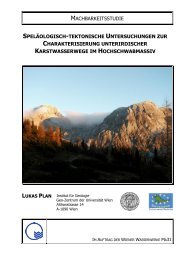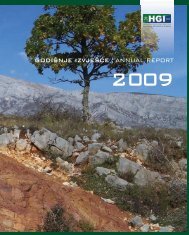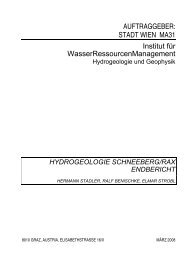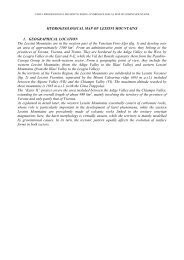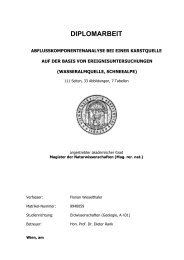Explanatory notes to the digital geological map of the Rax ... - KATER
Explanatory notes to the digital geological map of the Rax ... - KATER
Explanatory notes to the digital geological map of the Rax ... - KATER
Create successful ePaper yourself
Turn your PDF publications into a flip-book with our unique Google optimized e-Paper software.
<strong>KATER</strong> II Geology <strong>of</strong> <strong>the</strong> <strong>Rax</strong>-Schneeberg-region<br />
__________________________________________________________________________________________<br />
INTERNAL THRUSTS<br />
An east-west directed compression has caused a synkline west <strong>of</strong> Heukuppe, which contains<br />
<strong>the</strong> tec<strong>to</strong>nic outlier <strong>of</strong> Hohe Gupf. Folding and westward directed thrusting in <strong>the</strong> adjacent<br />
Altenberg valley is also ascribed <strong>to</strong> this deformation act.<br />
Much more prominent for <strong>the</strong> hydrogeology <strong>of</strong> <strong>the</strong> Schneeberg-Nappe is a west directed<br />
internal thrust (Markgraben thrust) in <strong>the</strong> western Gahns plateau – see also cross section 4.<br />
The sou<strong>the</strong>rn margin <strong>of</strong> <strong>the</strong> Schneeberg-Nappe has been affected by backthrusting after <strong>the</strong><br />
deposition <strong>of</strong> <strong>the</strong> Upper Cretaceous <strong>to</strong> Palaeocene Gosau-Group. This Gahnsleiten<br />
Imbricates contain slices <strong>of</strong> Wetterstein reef and slope deposits with transgressively<br />
connected Gosau formations, as well as lenticular bodies <strong>of</strong> Wetterstein limes<strong>to</strong>ne and<br />
Werfen shales. The main part <strong>of</strong> <strong>the</strong> Schneeberg-Nappe is following above, beginning with<br />
<strong>the</strong> Anisian Gutenstein Formation.<br />
FAULT SYSTEMS<br />
The Krummbach fault system seems <strong>to</strong> be a strike slip fault (local flower structures in<br />
Krummbach valley and at Brettschacher) combined with a vertical <strong>of</strong>fset: <strong>the</strong> Schneeberg<br />
side has been uplifted, exposing older rocks and <strong>the</strong> underlying Göller Nappe in tec<strong>to</strong>nic<br />
windows, while <strong>the</strong> <strong>Rax</strong> side exposes <strong>the</strong> youngest part <strong>of</strong> <strong>the</strong> Wetterstein Limes<strong>to</strong>ne near <strong>to</strong><br />
<strong>the</strong> Schwarza valley floor.<br />
A younger fault system shows extensional character:<br />
The Weichtal normal fault has caused a displacement <strong>of</strong> about 600 m between<br />
Hochschneeberg (hangingwall) and Kuhschneeberg (footwall). The faults in <strong>the</strong> Großes<br />
Höllental seem <strong>to</strong> be a direct continuation <strong>of</strong> <strong>the</strong> Weichtal fault, but <strong>the</strong>y exhibit quite opposite<br />
movements: <strong>the</strong> western block (Heukuppe-Klobenwand) has been relatively uplifted about<br />
200 m compared with <strong>the</strong> eastern block (Preinerwand-Grünschacher).<br />
The Breitensohl normal fault forms <strong>the</strong> western margin <strong>of</strong> <strong>the</strong> tec<strong>to</strong>nic window <strong>of</strong> Hoher<br />
Hengst, displaces <strong>the</strong> Krummbach fault some hundred meters and continues in<strong>to</strong> <strong>the</strong> eastern<br />
Gahns massive. The normal displacement east <strong>of</strong> Hengst is 800 m as a minimum and<br />
degrees <strong>to</strong>ward south <strong>to</strong> about 400 m.<br />
The NNE-SSW directed fault system at Bodenwiese has squeezed up Lower Triassic Werfen<br />
shales probably by strike slip movements.<br />
MÜRZALPEN NAPPE<br />
The nor<strong>the</strong>rn margin <strong>of</strong> <strong>the</strong> Mürzalpen-Nappe is <strong>of</strong>ten affected by younger faults or covered<br />
by tec<strong>to</strong>nic outliers. Its eastern end is dipping down under <strong>the</strong> Schneeberg-Nappe and at its<br />
sou<strong>the</strong>rn margin it is thrusted over rocks <strong>of</strong> <strong>the</strong> Werfen Imbricates Zone.<br />
The Mürzalpen-Nappe has only minor influence on <strong>the</strong> <strong>Rax</strong>-Schneeberg-aquifere, <strong>the</strong>refore it<br />
is not treated here in detail.<br />
GÖLLER NAPPE<br />
The Göller-Nappe consists here mainly <strong>of</strong> Hauptdolomite, which is gradually replaced <strong>to</strong>ward<br />
<strong>the</strong> south by lagoonal Dachstein limes<strong>to</strong>ne. Sandy shales <strong>of</strong> <strong>the</strong> Carnian Raibl-Group act as<br />
a shear horizon during internal thrusting.<br />
The sedimentary succession continues in<strong>to</strong> Jurassic red limes<strong>to</strong>nes and marly/cherty basinal<br />
sediments <strong>of</strong> Allgäu Formation and locally in<strong>to</strong> red radiolarite.<br />
23



